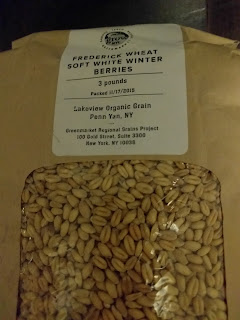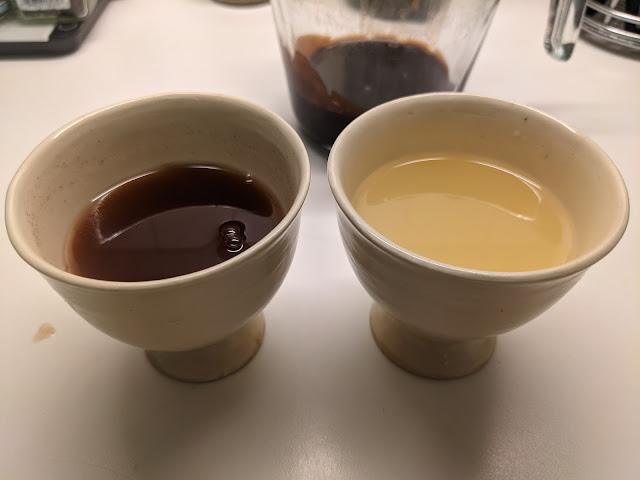I said I'd make these after Christmas, but schedules be damned, I'm going to do it early.
Earlier
I posted the close translation of the first of the exceptional yeast cake recipes. I'll redact it below, but since this is before making it I might need to come back with some changes and some refinements.
Before we start, though, I want to post a warning:
Most alcohol production is pretty safe. There are very few microbes that can grow in the acidic, alcoholic, nutrient-poor environment that is fermented wine, beer or what have you, and
also cause you ill. Yeast does a really good job at turning unfermented liquid into fermented liquid, so the window for spoilage that could cause illness is very small. Pretty much nobody worries about food safety when it comes to fermenting wine or beer at home. (1)
However. This recipe is a deliberate infection of grain with molds
without the presence of alcohol. It is entirely possible that molds which produce toxins may grow on the grain. I'm taking that risk on myself, and I will be the first one to drink the wine I produce. If you follow my recipe on your own, be aware of that risk. I would in particular avoid drinking wine produced with home-grown starters if you're immunocompromised.
Here's a paper describing the organisms found in some yeast starters. Part of my adjustment of this recipe is to add a small amount of commercial yeast starter so that you don't need to rely on whatever fungi you have in your house. But even the commercial yeast starters may have
Aspergillus flavus which can make toxins. Proceed with care.
Exceptional Yeast Cakes
Makes 3 pounds of yeast cakes, scale as appropriate. Original recipe is for 30L
Ingredients:
- 2 pounds of wheat berries, separated into two equal halves
- 1 pound of whole wheat flour, ideally from the same kind of wheat as your berries.
- Neutral oil for stir-frying
- Water
- Optionally, existing yeast starter balls or cakes, such as these
Tools:
- A quern (substitute a spice grinder, or a mortar and pestle and a lot of patience - food processors do not make flour well)
- A steamer
- A wok, or a large frying pan (at least 12", larger is better)
- A thatched-roof hut with doors and windows that may be sealed, and a clean floor (substitute a nearly air-tight container with a lot of air space in it)
- A weng capable of holding all the cakes (substitute a large glass jar, or tupperware with a lid)
Directions:
- Steam one half of the wheat until soft, about an hour. Check the water level after 30 minutes. Steaming the grain inside a cheesecloth helps to retrieve it, and helps make it moister while steaming.
- Simultaneously, stir-fry one half of the wheat until the grains turn yellow, but not burnt. Don't let the pan get too hot before adding the wheat in, since the grains will start popping and jumping. Constantly stir the grain, and stop when it starts to smell nutty and rich, about 10-15 minutes. If it smokes, you've gone too far.
- Grind each half of the grain into flour, as finely as you can. You may be able to use a food processor on the steamed grain. Then mix the steamed flour, the toasted flour and the raw flour together. If using, powder and mix in the yeast starter.
- Add water to the mixture until it just holds together, about 2 cups.
- Form the dough into flat round cakes 6 cm (2.4 inches) across, and 2.2 cm (0.85 inches) high. (2)
- Spread the cakes on the floor shoulder to shoulder, leaving enough space for you to walk through and flip them later.
- Appease your gods as you may.
- Seal up whatever space you're using to age them, so that wind does not enter. Keep the fermenting space at between 70°F and 85°F (3)
- Wait a week. Flip all the cakes and re-seal the space.
- Wait a week. Gather the cakes into a pile in the middle of the room and re-seal the space.
- Wait a week. Put the cakes into a weng and seal that weng.
- Wait a week. Bore a hole in the center of each cake and thread them on a piece of clean string. Air them in the sun to dry, and then store them inside.
And here's me getting started:
 |
| From the Union Square Greenmarket |
 |
| Three portions, because I didn't learn that ground up whole wheat is the same thing as whole wheat flour until afterwards. |
 |
| Wrapping the grain in cheesecloth, and using foil on top, helps the grain to moisten better. |
 |
| Never stop stirring |

 |
| Food processors do not make flour well. |
 |
| Spice grinders do! |
 |
| I could have just bought this though. |
 |
| Attempting to grind the toasted wheat - it's a little better... |
 |
| But there are some big grains in it. |
 |
| Spice grinder to the rescue! |
 |
| Steamed wheat. Tastes pretty normal. |
 |
| Milled. |
 |
| The final cakes are a little large but they'll do. |
 |
| Overflow |
 |
| Leftovers. I don't have more space to make cakes though. |
In about a month these should be ready... just in time to make some wine for King's and Queen's Arts and Sciences in February.
Footnotes:
- Brewers and vintners do worry about infections with spoilage organisms, but that's a quality and shelf-stability problem, not a health problem.
- Using the same source for unit conversions as I used for volume in this article, one "thumb joint" (寸) is 2.42 cm.
- This recipe is meant to be made in ~August, and based on the area where the author of this book, Jia Sixie, grew up in China, the modern average low in August is 70, and the average high is 85. The hut would moderate the temperature somewhat, but it would probably be in line with that. Temperature matters because it affects which molds grow best.




























Comments
Post a Comment